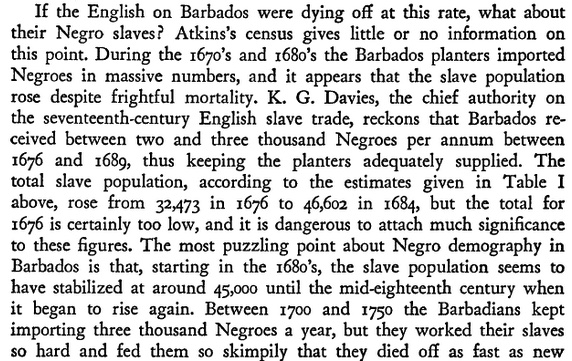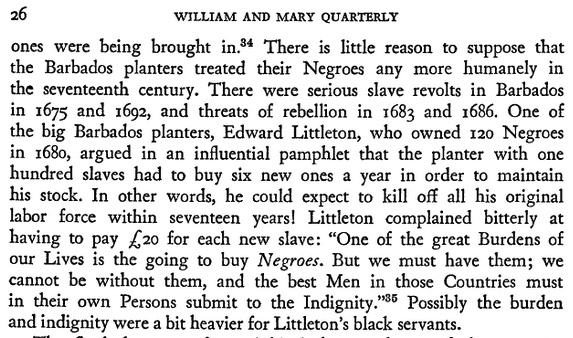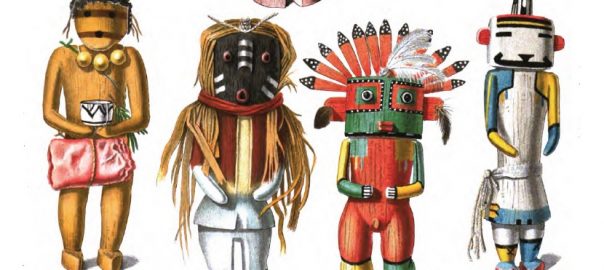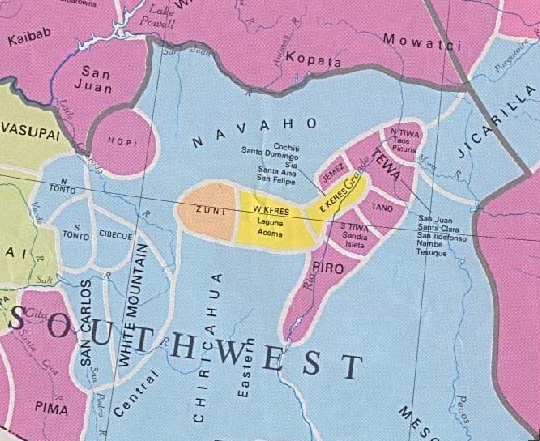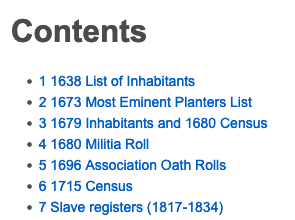The major development in the history of imperialism/anti-imperialism in 1680 CE was almost certainly the large-scale uprising that members of various Indigenous-American Pueblos launched against the Spanish colonizers in the area of today’s New Mexico. In today’s bulletin I will pull together what information I have time for on that uprising, then quickly survey the results of a census that that the English Governor of Barbados conducted in 1680 of the residents of that island colony so crucial to the development of empire and capitalism in England.
Pueblo Revolt in North America’s interior
English Wikipedia has a pretty good page on this revolt, and another on its main leader Popé or Po’pay, a Tewa religious leader from Ohkay Owingeh, which was named “San Juan Pueblo” by the Spanish.
The main WP page on the revolt gives extensive information about its background:
With the establishment of the first permanent colonial settlement in 1598, the Pueblos were forced to provide tribute to the colonists in the form of labor, ground corn, and textiles. Encomiendas [colonial plantations worked by enslaved indigenes] were soon established by colonists along the Rio Grande, restricting Pueblo access to fertile farmlands and water supplies and placing a heavy burden upon Pueblo labor.
Especially egregious to the Pueblo was the assault on their traditional religion. Franciscan priests established theocracies in many of the Pueblo villages. In 1608, when it looked as though Spain might abandon the province, the Franciscans baptized seven thousand Pueblos to try to convince the Crown otherwise.
That’s interesting! The Spanish metropole authorities (the King?) was thinking of pulling back from the area– but the Franciscan messianists were either so invested in their evangelization project or were so happy with the local power it gave them that they wanted to stay… And the Franciscans were strong enough in Madrid that they could persuade the king to do as they wanted?
Here’s another window into the power of the Franciscans in the colonization project:
Fray Alonso de Posada (in New Mexico 1656–1665) outlawed [traditional] Kachina dances by the Pueblo people and ordered the missionaries to seize and burn their masks, prayer sticks, and effigies. The Franciscan missionaries also forbade the use of entheogenic drugs in the traditional religious ceremonies of the Pueblo. Several Spanish officials, such as Nicolas de Aguilar, who attempted to curb the power of the Franciscans were charged with heresy and tried before the Inquisition.
Then in the 1670s drought stalked the region and this happened:
The unrest among the Pueblos came to a head in 1675. Governor Juan Francisco Treviño ordered the arrest of forty-seven Pueblo medicine men [a colonialist term for traditional religious leaders] and accused them of practicing “sorcery”. Four medicine men were sentenced to death by hanging; three of those sentences were carried out, while the fourth prisoner committed suicide. The remaining men were publicly whipped and sentenced to prison. When this news reached the Pueblo leaders, they moved in force to Santa Fe, where the prisoners were held. Because a large number of Spanish soldiers were away fighting the Apache, Governor Treviño was forced to accede to the Pueblo demand for the release of the prisoners. Among those released was… “Popé”.
Following his release, Popé, along with a number of other Pueblo leaders… planned and orchestrated the Pueblo Revolt. Popé… spent the next five years seeking support for a revolt among the 46 Pueblo towns… The Spanish population of about 2,400, including mixed-blood mestizos, and native servants and retainers, was scattered thinly throughout the region. Santa Fe was the only place that approximated being a town. The Spanish could only muster 170 men with arms. The Pueblos joining the revolt probably had 2,000 or more adult men capable of using native weapons such as the bow and arrow. It is possible that some Apache and Navajo participated in the revolt.
… Popé’s plan was that the inhabitants of each Pueblo would rise up and kill the Spanish in their area and then all would advance on Santa Fe to kill or expel all the remaining Spanish. The date set for the uprising was August 11, 1680. Popé dispatched runners to all the Pueblos carrying knotted cords. Each morning the [local] Pueblo leadership was to untie one knot from the cord, and when the last knot was untied, that would be the signal for them to rise against the Spaniards in unison. On August 9, however, the Spaniards were warned of the impending revolt by southern Tiwa leaders and they captured two Tesuque Pueblo youths entrusted with carrying the message to the pueblos. They were tortured to make them reveal the significance of the knotted cord.
Anyway, this was a slight blip in the plan which Popé dealt with by bringing the launch-date forward by a day. (Not everyone got that message, but enough did.)
…On August 10, the Puebloans rose up, stole the Spaniards’ horses to prevent them from fleeing, sealed off roads leading to Santa Fe, and pillaged Spanish settlements. A total of 400 people were killed, including men, women, children, and 21 of the 33 Franciscan missionaries in New Mexico. In the rebellion at Tusayan (Hopi) churches at Awatovi, Shungopavi, and Oraibi were destroyed and the attending priests were killed. Survivors fled to Santa Fe and Isleta Pueblo, 10 miles south of Albuquerque…
By August 13, all the Spanish settlements in New Mexico had been destroyed and Santa Fe was besieged. The Puebloans surrounded the city and cut off its water supply. In desperation, on August 21, New Mexico Governor Antonio de Otermín… sallied outside the palace with all of his available men and forced the Puebloans to retreat with heavy losses. He then led the Spaniards out of the city and retreated southward along the Rio Grande… The Puebloans shadowed the Spaniards but did not attack. The Spaniards who had taken refuge in Isleta had also retreated southward on August 15, and on September 6 the two groups of survivors, numbering 1,946, met at Socorro. About 500 of the survivors were Native American slaves. They were escorted to El Paso by a Spanish supply train. The Puebloans did not block their passage out of New Mexico.
So then the Popé/Po’pay page takes up the story:
Po’pay had succeeded in expelling the Spanish from New Mexico and according to later accounts, possibly prejudiced, set himself up as the sole ruler of all the Pueblos. He attempted to destroy every trace of the Spanish presence in New Mexico. “The God of the Christians is dead,” he proclaimed. “He was made of rotten wood.”
A Spanish force of 300 men attempted to regain a foothold in New Mexico in 1681, but was repelled by Po’pay’s army. Another Spanish effort in 1687 also failed…
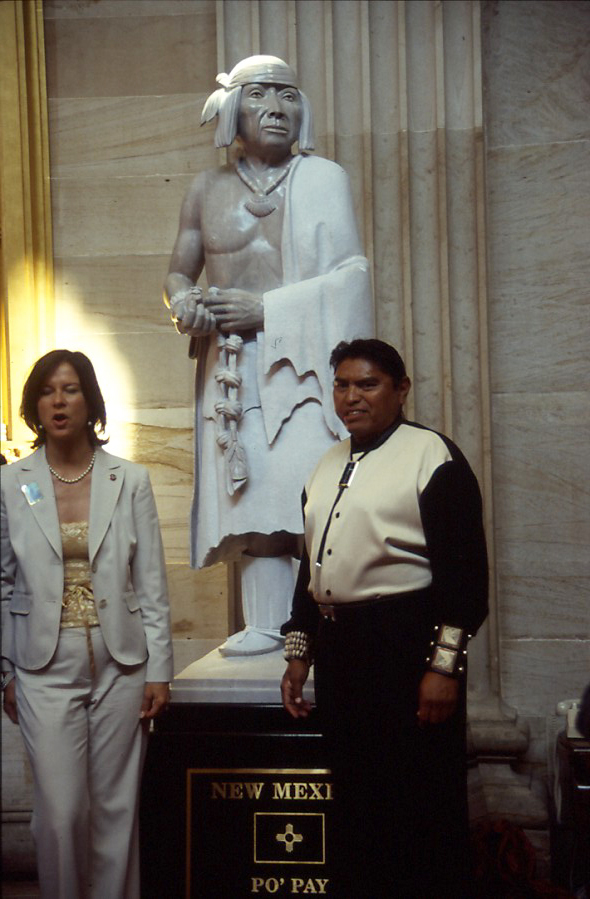
It wasn’t until 1692 that the Spanish were able to retake the region, and when they did, their rule was noticeably less harsh than prior to 1680. These are a couple of summaries of Po’pay’s achievements from his page on WP:
As stated by Matthew Martinez of Po’pay’s home Pueblo, Ohkay Owingeh, “it took a unique individual to orchestrate the revolt across two dozen communities who spoke six different languages and were sprawled over a distance of nearly 400 miles.”
… [T]he relations between Spanish and the Pueblos was far different after the revolt than before. The dreaded encomienda system (forced labor) was prohibited in New Mexico. Franciscan priests did not interfere with Pueblo religious ceremonies provided that the Pueblos observed the outward forms of Catholicism…
By the way the banner image at the top here is a picture showing some sacred kachina dolls from Pueblos of the area.
The 1680 census of Barbados
I suppose you could think of early European colonies in the non-European world as being among the earliest of the modern world’s “planned communities.” I mean, throughout human history, wherever there were taxes to be paid and conscripts to be enrolled, the authorities have wanted to have general headcounts and an idea of how rich people were, etc. But when it came to colonies like the extremely profitable English sugar-plantations of Barbados, there were also investors back home to keep informed (or at least, mollified) and maybe other reasons for taking censuses, too…
Thus we see that in Barbados, censuses of varying degrees of completeness had been carried out and recorded since 1638– whereas back home in metropolitan England, systematic national census-taking didn’t start till 1801! And some of the Barbados censuses were very revealing, including the one taken in 1680.
In 1969, historian Richard Dunn tracked down and analyzed a box of records of a census that Barbados governor Jonathan Atkins had compiled in 1680. You can find an article Dunn wrote on his findings in The William and Mary Quarterly on JSTOR, here. He wrote (pp.3-4):
The detailed lists Governor Atkins sent home demonstrate that there was an elaborately developed social hierarchy in Barbados at the time it was the richest and most populous colony in English America. The correlation between economic wealth, social privilege, and political power in Barbados is very striking…
Barbados was at the height of its wealth and power in 1680. Unquestionably the big sugar planters on the island were thee wealthiest men in English America. Though they no longer made the fantastic profits they had enjoyed in the 1640s and 1650’s when Barbados sugar first came on the London market, their volume of production had risen greatly in thirty years… Almost certainly the exports to England from this small island of less than one hundred thousand arable acres were more valuable in 1680 than the total exports to England from all the [mainland] North American colonies.
So here are a few of the tables that Dunn compiled from Atkins’s records and other records he found:
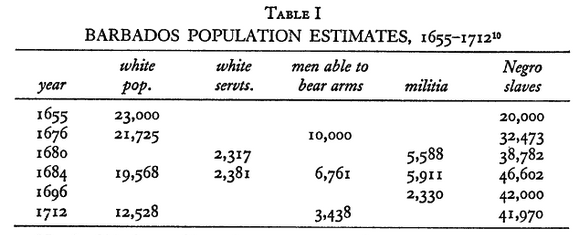
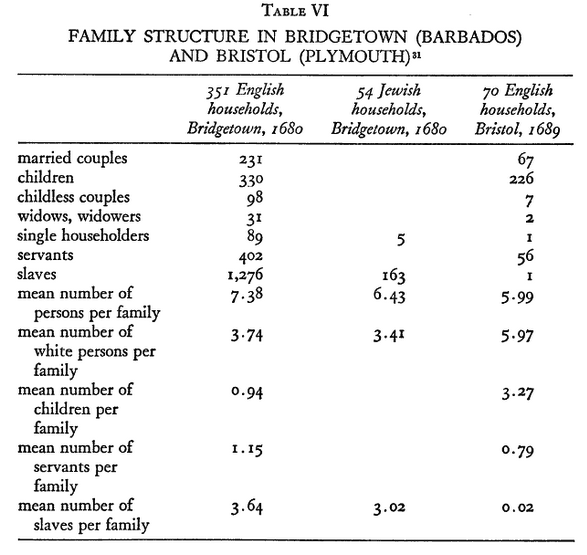
In Table VI, look at the last row.
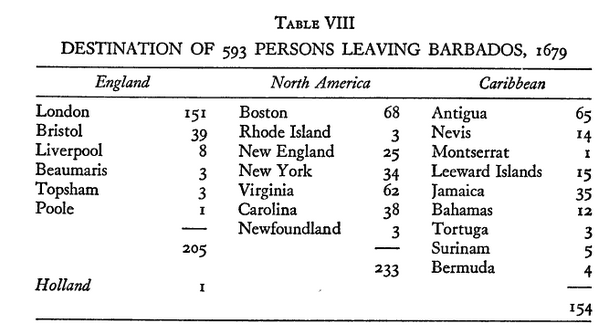
In Table VIII, see how many of the people (= colonists) leaving the island headed up to English colonies in mainland North America.
The observations he shared about the numbers of enslaved persons working in Barbados are worth reading in full (pp.25-26):
